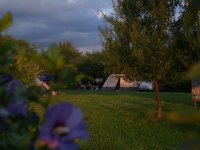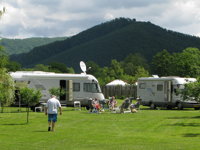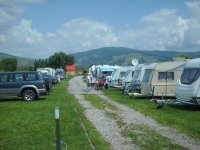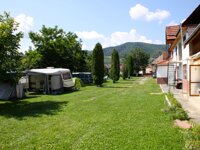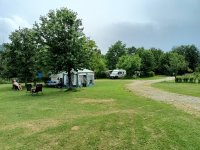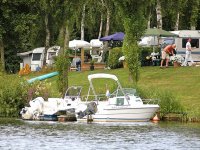Camping in Romania
6 campsites in Romania
Campsite Listing Google Map
The following consent is required:
Tracking & performance, Targeting & advertising.
Romania
Perhaps best known for Transylvania, the location of Dracula’s Castle, Romania is a land of fertile plains, meandering rivers and splendid mountains.
The Carpathians traverse the centre of the country and the Danube ends its journey here in the Black Sea, forming one of the most interesting wetlands in the world: the Danube Delta.
There are few campsites in Romania situated in Transylvania, one of which is the aptly named Vampire Camping. Bran Castle is now a museum open to tourists and displays art and furniture collected by Queen Marie. A trip to Bucharest offers impressive architecture, visual arts and music.
Start your search for campsites in Romania with Alan Rogers. Choose sites offering pitch or mobile home accommodation and refine your results to find the ideal destination for your holiday.
Unknown matrix block type: tableOfContents2!

Basic information
Capital Bucharest
Currency Romanian Leu (RON)
Language(s) Romanian
Time Zones EEST (UTC+2)
Summer (DST) EET (UTC+03)
Telephone Code +40
Units Metric
EU Member Yes
Schengen Area No
Tourism Website www.romaniatourism.com
Romania is not yet a member of the Schengen Area, and customs inspections are conducted on individuals and vehicles crossing the border to ensure compliance with local regulations.
Shopping in Romania

Located in the Balkans, Romania is a country with a long tradition of craftsmanship. One of the best cities for shopping is Bucharest, its capital, where most national stores and international firms are concentrated. Among the typical items that can be purchased throughout the country are handmade wooden figures. Also, pottery is very popular, as well as glassware, porcelain and textiles, of which rugs, embroideries and traditional clothing are the most common. Another of the most valued products in Romania is cosmetics, among which the brands Pellamar and Gerovital stand out.
Romania has numerous modern shopping malls in major cities like Bucharest, Cluj-Napoca, Timișoara, and more. These malls offer various international and local brands, fashion outlets, electronics stores, entertainment options, and food courts. Some popular malls include AFI Palace Cotroceni (Bucharest), Iulius Mall (Cluj-Napoca), and Promenade Mall (Bucharest)
Traditional markets are an integral part of Romanian shopping culture. You can find fresh produce, local specialities, clothing, handicrafts, and more here. One famous market is the Obor Market in Bucharest, one of the city's oldest and most significant markets.
Many cities in Romania have vibrant shopping streets lined with boutiques, fashion stores, and speciality shops. For instance, Lipscani Street in Bucharest is known for its trendy boutiques, art galleries, and cafes.
In larger cities, shopping centres typically operate from around 10:00 a.m. to 10:00 p.m. Monday through Sunday. These hours can vary slightly depending on the specific centre and location. Some malls might have extended hours on weekends. Smaller stores, including grocery stores, clothing boutiques, and other shops, usually open around 9:00 a.m. and close between 6:00 p.m. and 8:00 p.m. on weekdays.
Romanian Money

Romania is increasingly a card economy. An extensive network of ATMs accepts standard international credit and debit cards, but you may incur a fee.
Check with your card provider whether you can use these machines. Sterling and most Western currencies can usually be exchanged for local cash at large exchange bureaux in towns and cities.
Banknotes and coins are issued in various denominations, ranging from small coins to larger banknotes.
Public Holidays in Romania
- New Year's Day: January 1st
- Day after New Year's Day: January 2nd
- Unification Day: January 24th
- Good Friday, Easter Sunday, Easter Monday
- Labour Day: May 1st
- International Children's Day: June 1st
- Pentecost Sunday, Decent of the Holy Spirit
- St Mary's Day: August 15th
- Feast of St Andrew: November 30th
- National Day: December 1st
- Christmas Day: December 25th
- Second Day of Christmas: December 26th
- Please note Some dates are moveable, so please check before travelling.
Driving in Romania

Visitors to Romania who wish to drive in the country must comply with the following requirements:
- A valid driver's license: Visitors must have a valid driver's license from their home country.
- Car insurance: Visitors must have valid car insurance for their vehicle, covering both the driver and passengers.
- Road rules: In Romania, you drive on the right and overtake on the left. If you intend to overtake or change lanes, you should indicate. Visitors must follow Romania's traffic laws, including speed limits, traffic signals, and road signs.
- If your vehicle does not have the UK identifier within the number plate, you will require a UK sticker when driving in Romania.
- Camper vans and cars with caravans are not allowed to exceed 12 metres in length, 4 metres in height and 2.55 metres in width.
- Safety equipment: It is mandatory to carry a warning triangle, A fire extinguisher, A first-aid kit,
- Headlamp beam deflectors must be used (depending on your car, you will either need deflector stickers or have to adjust the beam manually)
- Minimum driving age: The minimum driving age is 18.
- Romania uses an electronic road tax system to collect tolls. The tax is payable at border crossing points, post offices and other institutions throughout the country. The tax is paid, and your vehicle’s information is stored on a central government database.
- The maximum level of alcohol in the blood allowed is 0.00%.
- Overall, road quality in Romania is not ranked highly by international organisations. Roads in (and between) main cities are in decent condition, but elsewhere in the network, you should proceed with caution. Mountain roads can be tricky at the best of times, and they’re very dangerous in snowy or icy conditions.
Emergency Services in Romania
- European Emergency Number 112
Romanian Weather
BUCHAREST WEATHERThe weather in Romania can vary greatly depending on the region and the time of year. Romania has a temperate-continental climate, which means it experiences distinct seasons: spring, summer, autumn, and winter. Here's a general overview of the weather you can expect in different seasons:
Spring in Romania is characterised by gradually warming temperatures and blooming landscapes. March can still be chilly, especially in the northern regions, but by May, temperatures start to become more pleasant. Spring is a great time to visit as the countryside comes to life with colourful flowers and greenery.
Summers in Romania are generally warm, especially in July and August. The coastal areas along the Black Sea can get quite popular during this time. Inland regions, including cities like Bucharest and Cluj-Napoca, can also experience high temperatures. It's a popular time for outdoor activities and festivals.
Autumn is a beautiful time to visit Romania, with cooler temperatures and vibrant foliage. September and early October still offer mild and comfortable weather, while November tends to be calmer and marks the transition to winter. This is an excellent time to explore the countryside and enjoy the autumnal colours.
Winters in Romania can be cold, especially in the mountainous regions. The Carpathian Mountains receive snowfall, making them famous for winter sports like skiing and snowboarding. Cities like Bucharest also experience colder temperatures and occasional snow.
